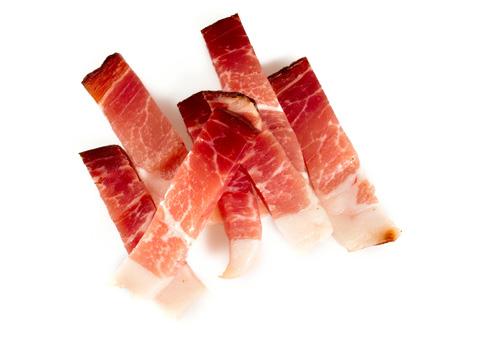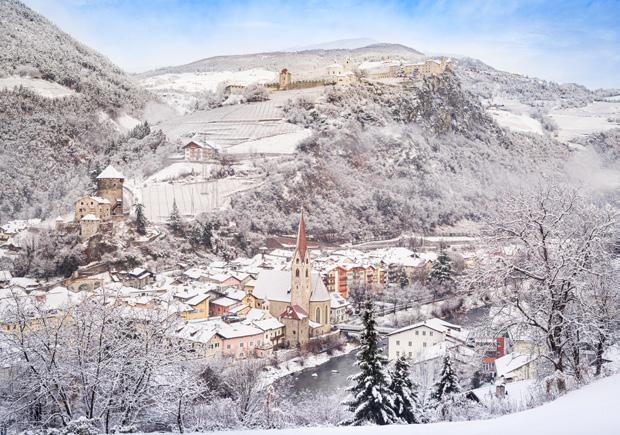
3 minute read
Q&A with… Johann Mantinger, South Tyrol’s fastest speck slicer
Q&A with…
Johann Mantinger, South Tyrol’s fastest speck slicer
Advertisement
Johann Mantinger, 62, can slice speck more quickly than an entire football team can eat it.



Johann, what does it take to become the fastest speck slicer in the region? I participate in all sorts of competitions. Sometimes the judges are looking for precision and sometimes it only comes down to speed. Once I was up against 18 other competitors and was able to cut twice as many bite-sized portions as the runner-up. Another time, I competed against an entire male veterans football team from Cologne: I betted that I could slice five kilograms of speck faster than they could eat it. And I won! even been interviewed by the BBC. Everyone calls me “Gletscher-Hans”, which means “Glacier Hans”.
“Glacier Hans”? Why not “Speck Hans”? Because I used to be a ski instructor. One of my pupils found my name too difficult to remember so she renamed me “Glacier Hans”. And it’s stuck. The Italians call me “Giovanni del ghiacciaio”, which is the perfect translation of my German nickname!
How he does it A true speck connoisseur like Johann has no need to use a cutting machine. All that’s required is a sharp knife, a typical South Tyrolean speck board and lots of muscle power! He cuts a piece of the cured ham, around three centimetres thick, lengthways from the joint, removes the rind and slices it as thinly as possible. If the speck is to be used to make traditional dumplings, it needs to be chopped into small cubes and not slices. Do you cure speck yourself? Of course I do! I’m a small-scale farmer with twenty pigs. Speck is my life, professionally and privately. I look after my piglets as if they were my babies. I’ve actually become a bit of a star. I’ve appeared on TV cooking shows and have
Discover an Artist’s Town
Shopping, indulgence, and culture in Klausen/Chiusa
Little Klausen, situated in the lower Eisacktal valley, was selected as one of the “Borghi più belli d’Italia”, i. e. one of Italy’s most beautiful historic towns. The medieval flair of its alleys and striking town houses with their narrow, beautifully coloured façades has always been a magnet for artists and poets. The Säben Mountain towering over the valley is home to what was once one of the most important episcopal sees of Tyrol. Säben—now a Benedictine convent—as well as the Gothic churches in town, the Capuchian monastery, and the mighty Branzoll castle are testament to the town’s history as a mediaeval customs station. Approx. 2,500 people live in Klausen, nestled among a picturesque landscape of vineyards and chestnut groves that have seen centuries of active farming. The town was Albrecht Dürer’s source of inspiration for the copper engraving titled “The Great Fortune”, depicting the Greek goddess Nemesis balancing on a sphere over the town. In this modern day and age, numerous little owner-run shops and trendy independent boutiques attract shoppers to stroll along the historical old town streets. Check out the colourful flower vendors,

find traditional and modern craftwork, shop top-of-the-range women’s fashion, and explore native, regional, and fair-trade products. The inns situated alongside Klausens’s winding alleys have been around for centuries, serving guests back when the main road from the Brenner/ Brennero pass to the South still crossed right through the town. Today, the town inns offer plenty of home-made, traditional Alpine dishes from South Tyrol as well as Italian-Mediterranean specialities.
Every year, during the Medieval Christmas market, Klausen’s winding alleys and colourful historic town houses are bathed in candlelight.
Store opening hours
+ Monday through Friday, from 9 am to 12 pm and from 3 pm to 7 pm Saturday 9 am to 12 pm
www.klausen.it/shopping
Stadtmuseum (Klausen municipal museum)
+ The museum is open from the end of March through the beginning of November from Tuesday through Saturday, 9.30 am to 12 pm and 3.30 pm to 6 pm. The Stadtmuseum is closed on Sundays, Mondays, and public holidays.
www.museumklausenchiusa.it
Medieval Christmas
+ The Christmas market transports visitors back to the Middle Ages on all four Advent weekends from Friday to Sunday from 10 am to 7 pm











